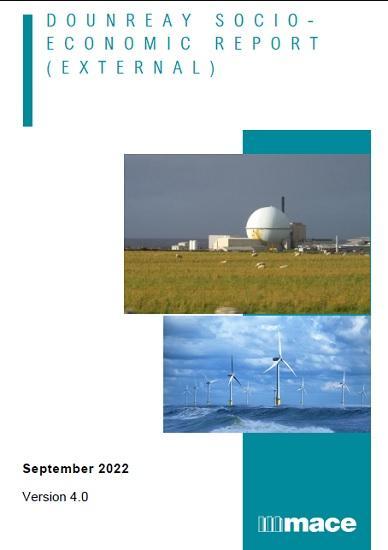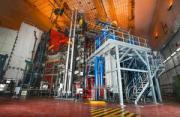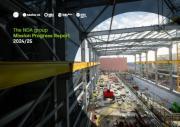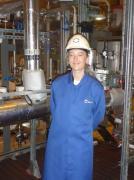DOUNREAY SOCIO - ECONOMIC REPORT 2022
10th October 2022

Executive Summary
The Nuclear Decommissioning Authority (NDA) commissioned this report. It provides an update to previous reports in 2006, 2012, and 2016 on the social and economic importance of the Dounreay site
within its local area of Caithness and North Sutherland. It also provides a review of the Caithness and North Sutherland Regeneration Partnership (CNSRP) which is the organisation established to promote economic growth in the area as the Dounreay site decommissions over the coming years. It draws some conclusions on these matters.
The Dounreay site has been in its decommissioning state since 1994. The projected Interim End State (IES), when operational activity will cease has changed several times since then, the last review of the IES in 2016 projected it would be achieved by 2033. The next review of the Lifetime plan is due in 2023. This report provides an update to the 2016 report using the 2016 lifetime plan, where appropriate.
The main findings of this report are:
The Dounreay (DSRL) employee base
Employment at Dounreay is vital to the area. The site employs 1283 employees, of which about 1,232 live in Caithness and Sutherland. In addition, there are 700 supply chain workers at the site. Contrary to expectations in 2016 the number of employees is 15% higher than it was in 2016. Because of this growth, the site is actively hiring and taking on apprentices. Some 12% of the workforce is aged under 25, whilst the average age of employees is 43 years and 6 months.
Locally based employees represent about 11% of all Caithness and Sutherland employment and that rises to 15% if workers in the public sector are excluded. Workers at Dounreay earn approximately £10,000 above the Highland region average. As such their salaries represent about 15% of the payroll in Caithness
and Sutherland.
This is not a decaying and ossified workforce. It remains the single largest contributor to payroll in Caithness, apart from public services such as health and education. Given the relative youth of the workforce, most of the current workforce (62%) will not have reached retirement age by the time the current IES arrives in 2033.
Caithness and Sutherland have strong skills and expert knowledge in the nuclear industry and currently the nuclear decommissioning process. There are many transferable skills where that expertise can be used in other sectors and industries locally. Such skills are particularly suited to the wider nuclear decommissioning sector, emerging energy sector, and space sectors.
The Local Population
The population of the area (both Caithness and Caithness and Sutherland) has declined slightly since 2005. The current population is about 1-2% lower, and 2-3% below the peak in 2014. About 60% of the decline is due to natural population change (deaths exceeding births), implying the remainder is due to net
out flows of migrants.
Data from the Highland area suggests the wider area is losing younger people. If this pattern holds for Caithness and Sutherland, then fewer young people today means fewer prospective first time parents in 5-10 years' time which, in turn, will reduce the birth rate even further. Young people are probably leaving to attend universities elsewhere in Scotland. Scotland has eight universities in the UK top 50 (compared to 9 for the North of England, which has three times the population). Five of the top 8 Scottish Universities
naturally cluster around Glasgow and Edinburgh with other locations being in Dundee, Stirling, and Aberdeen.
These factors combined with increasing life expectancy for older people, results in the area having a changing population profile. There are fewer young people, fewer working age people and more old people. Whilst this broad trend is evident in both UK wide and Scotland wide data, it is much more pronounced in data for the HIE area in general, and Caithness and Sutherland in particular.
In 2001, 20% of the Highland area's population were aged 0-15 years. Today it is 14%. In 2001 working aged people (16 to 64) constituted 63% of the Highland population, today it is 62% and projected to be 56% in 2043. The proportion of older people was 17% in 2001, 24% in 2020 and projections expect it will be 29% in 2043.
The dependency ratio is therefore increasing. Whilst this ratio was only four points higher for Highland than Scotland in 2001, it will be 13 points higher by 2043. This will have implications for public services.
School admissions will fall, whilst an aging population will put pressure on health and social care services.
Economic inactivity (people of working age not in employment, education, or training) rates in the Highland area are below the average for Scotland. In terms of claimant count this is 2.2% in Caithness and Sutherland. This rate is about half the UK rate (4.4%) and below the Scottish rate of 3.7%. Combined this means there is not a significant pool of workless adults who could re-enter/enter the workforce to offset the demographic challenges outlined above.
The Local Employment, Business Base and Economy
The population pressures probably explain why Caithness and Sutherland's employment base has fallen slightly since 2005. This fall is as much a consequence of demographic trends as employment trends. Companies can only hire if the workers are there to be hired.
The importance of Dounreay is evident when analysing the area's employment base. Caithness has a location quotient of 5.91 for mining, quarrying and utilities, indicating that people in the area are nearly 6 times more likely to be employed in this sector than the Scottish average. This only falls to 4.40 when looking at Caithness and Sutherland. These location quotients have grown since 2005 indicating both the continued importance of Dounreay and the growth in new jobs linked to offshore wind.
One of the fastest growing sectors in Caithness and Sutherland over the last 15 years has been in professional, technical, and scientific sectors. Employment in these areas has increased by 65% since 2005. The area clearly has an existing strength in utilities and an emerging strength in scientific and technical sectors. By contrast Caithness and Sutherland lost significant jobs in health (500), manufacturing (650) and business administration (940) since 2005.
These reductions mean the area's employment base is more concentrated on its core strengths than it was in 2005.
While the employment base in the Caithness area has been falling, the business base is increasing, with a marked growth in scientific and technical organisations (which have almost doubled in 11 years). These trends mean that the average number of employees per business have fallen and suggest that more people are working in small start-up enterprises than 15 years ago.
Over the last 12 years in the Highland area, and more generally in Scotland, there has been higher wage growth when compared to the UK. Statistical evidence indicates that in 2010 wages in the Highland area were £50 per week lower than the UK average, in 2021 it was equal.
Dounreay has a dualist relationship with the local economy. While Dounreay is the anchor of the local economy, it is also competing against other companies and industrial sectors for staff. While Dounreay is attracting skilled people on higher wages, it crowds out other companies in hiring people. This may impact the growth prospects of local companies.
Economic analysis suggests that Dounreay has a GVA per employee of £55,900 per annum. This is almost double the Highland Council area figure and shows the importance of Dounreay to the local area.
In total the economic data suggests Dounreay contributes £77.5m per annum to the local economy.
This suggests that when the decommissioning work ends the average wage level may drop, reducing spending power of the local population, unless similar high skilled opportunities are found for the
decommissioning staff that are able to harness those skills and prevent them from leaving the area. The percentage of high-tech businesses in Caithness has begun to increase. This is a positive
development which perhaps reflects a "local bounce" related to the significant growth in that sector in other areas of Scotland. This welcome development provides an excellent platform for local leaders and the Caithness and North Sutherland Regeneration Partnership (CNSRP) to harness the workforce strengths, expertise, and natural geography of the locality.
Caithness and North Sutherland Regeneration Partnership (CNSRP)
Mace have analysed the strategic, governance and operations of the CNSRP. It has been successful in attracting new industries to the area, such as the offshore wind farm and satellite launching facility and meeting the lower end of the job targets spectrum (as per the CNSRP programme manager update to the Dounreay Stakeholder Group (DSG) in October 2021).
However, the introduction of large major projects in the Dounreay area does not necessarily lead to a high number of skilled jobs for local people. For example, the area has been successful in bringing two highly innovative and notable projects to the area yet with limited job opportunities so far in Caithness.
• The BOWL offshore wind project has mainly created jobs in Germany (manufacture) and Hull (assembly). However, it is pleasing to note that around 90 people located in Wick are required for maintenance services. These are well paying jobs in an area which suffers from deprivation. In addition, these jobs will support further roles in the economy through indirect and induced effects.
At the time of writing, the Crown Estate Scotland is in the process of letting new contracts for leases in the North Atlantic/North Sea area. These contracts will include local supply provisions, so
the number of local jobs in Caithness in the offshore wind sector should increase significantly over the coming decade.
• The Space hub is well located in North Sutherland for the launch of low-earth-orbit observation satellites in polar and sun-synchronous orbits. This will create 40 jobs by 2024.The main launch vehicle provider is based in Forres (Moray) and is building a significant workforce at their factory there (potentially as many as 400 eventually). The space cluster investigations undertaken through the chamber and supported by Jacobs demonstrate significant potential job growth in the North Highlands and Moray (Space Cluster - CNSRP (cnsrp.org.uk).) Resourcing and developing the space cluster opportunities to be local is an important element of the CNSRP programme.
It is likely that this is due to both the demographic issues of the area coupled with the dominant effect of Dounreay in the area. The area does not have sufficient spare labour to capture more of the value created by these projects and its skilled labour is still drawn to the relative security of Dounreay. Solving this difficult problem will be key to securing the local economy (along with other issues such as transport and finding developable land) through the transition of Dounreay's decommissioning and beyond.
The overall governance structure is effective and has the appropriate membership. All parties are engaged with the process. Attendance has improved (due to video conferencing), and perhaps this could be a permanent way for people to join future meetings.
The CNSRP is solely focussed on this part of the world, which enables it to apply all its efforts to the local communities without distraction from other areas outside the region. The partnership is also well chaired.
Some of the stakeholders interviewed indicated that addressing the wider socio-economic impact has not been fully embedded in DSRL's decommissioning process. This would have the objective of maintaining continuity of employment in the area. This will be a crucial factor in retaining the skilled people in the area (and their families) and making it less likely they will leave to pursue skilled opportunities elsewhere. However, the demographic issues due to an increasing loss of younger people combined with a significantly ageing population also present an opportunity for the area.
Conclusion
Caithness and North Sutherland have benefited economically from the presence of Dounreay. It has anchored the local economy for decades. This has continued recently as employee numbers have grown since 2016 (contrary to the expectations of the 2016 projection on the IES).
However, the likely decline in employment numbers in the future as the IES approaches will create challenges for the local economy and the demographic issues will magnify these. The local population is both shrinking and aging due to increased life expectancy, a natural decline, and net outflows of young people. The worst-case scenario is that when Dounreay reaches its IES it accelerates these trends, resulting in a population structure which is more unbalanced than current predictions suggest.
This scenario is by no means inevitable. There is an opportunity to ensure the area has a positive future after Dounreay reaches its IES. It has a core skills base, with niche and high demand skills in the energy and utilities sector. These skills combined with its physical geographic advantages for space, wind, and
tidal mean there is every chance Caithness and North Sutherland could have a bright future. In addition, the developments at Scrabster and Wick harbours show that with investment the area can continue to prosper.
Read the full report HERE
94 pages Pdf
Related Businesses
Related Articles
TAE Technologies and UKAEA partner to commercialise fusion tech
Joint venture to develop neutral beams for fusion and non-fusion applications, creating high-skilled jobs and establishing a critical supply chain. TAE Technologies, a leading US private fusion energy firm with over 25 years at the forefront of scientific innovation, today announces a bilateral and reciprocal investment commitment with the United Kingdom's national fusion laboratory, the UK Atomic Energy Authority (UKAEA) to commercialise TAE's proprietary particle accelerator technology for the global market.
Buried Hazards, Unfinished Business - What the NDA's 2025 Progress Report Really Tells Us
The Nuclear Decommissioning Authority (NDA) has released its 2025 Mission Progress Report is a slightly sprawling document chronicling one of the UK's most complex environmental undertakings. The safe dismantling of its early nuclear legacy.
New recruit officers join the Civil Nuclear Constabulary
The Civil Nuclear Constabulary (CNC) welcomes its newest recruits. The CNC hosted two passing out parades for the graduating Authorised Firearms Officers (AFOs) of Initial Foundation Programme (IFP) 106.
Dounreay's next generation of talent honoured by apprentice award
Nuclear Restoration Services Dounreay's Kate Thomson has won Modern Apprentice of the Year at the Highlands & Islands Apprenticeship Awards in Inverness. Kate, who is in the second year of her apprenticeship in commercial and quantity surveying, said she was thrilled by the honour.
Taskforce calls for radical reset of nuclear regulation in UK
Nuclear Regulatory Taskforce publishes final report and calls for radical reset of overly complex nuclear regulatory system. An overly complex nuclear regulatory system has contributed to the "relative decline" of the UK's ability to deliver faster and cheaper nuclear projects.
Funding approved for Wick Harbour port consultant
A specialist ports consultant has been appointed to develop a long-term strategic plan for Wick Harbour Authority (WHA) in Caithness. WHA has secured £47,775 from Highlands and Islands Enterprise (HIE) and the Nuclear Restoration Services, NRS Dounreay towards the cost of the services.
Fallon Campbell From Melvich Near Thurso Named As Apprentice of the Year At Awards In London
Rising star from North Scotland honoured at event to celebrate brightest and best in industry. An electrical apprentice from North Scotland is celebrating after being recognised for her contribution to industry at the 13th annual Engineering Construction Industry ECI Training and Development Awards in London.
The NDA Group Graduate Programme: more than a job
The NDA group graduate scheme offers far more than just a stepping stone into the nuclear industry; it's a chance to grow professionally, explore new places, and become part of a supportive community. Nuala Ledward, Assurance and Performance Graduate, shares how her secondment to Dounreay brought these benefits to life.
UKAEA develops 3D printing for fusion components
At its recently opened Central Support Facility (CSF), UKAEA has commissioned an electron beam additive manufacturing machine that can be used to incorporate tungsten into components, alongside a selective laser manufacturing machine. Fusion can play a key role in a global low carbon energy future.Advancing Fusion Remote Maintenance: Industry Collaboration Driving Innovation
As part of the Fusion Futures (FF) programme, UKAEA's Remote Applications in Challenging Environments (RACE) has partnered with industry leaders to develop two groundbreaking technologies for remote maintenance in fusion energy engineering. Thanks to FF funding, industry has taken the lead in maturing UKAEA technology concepts—delivering real-world solutions that enhance operational autonomy and reduce maintenance burdens in extreme environments.
